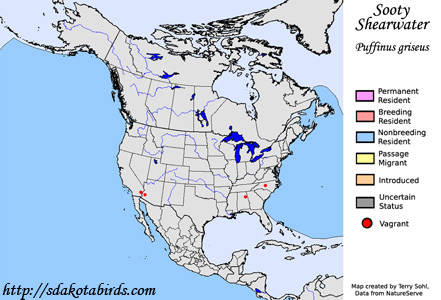| Length: 17 inches | Wingspan: 40 inches | Seasonality: Non-resident in South Dakota |
| ID Keys: Dark brownish plumage overall, some lighter gray central parts of the underwing, relatively long dark bill. | ||
 The
Sooty Shearwater is one of the most common birds off the California coast in
the late summer, but they are only visitors to north America. They are
extremely long distance migrants, as their breeding grounds are on islands
in the far southern Atlantic and Pacific Oceans. After breeding, they
disperse widely at sea, but make general movements northward along the west
side of the Pacific and Atlantic Oceans, before moving eastward and
migrating southward along the east side of the Pacific and Atlantic.
They can be found as far north as Alaska and northern Canada in the Northern
Hemisphere summer.
The
Sooty Shearwater is one of the most common birds off the California coast in
the late summer, but they are only visitors to north America. They are
extremely long distance migrants, as their breeding grounds are on islands
in the far southern Atlantic and Pacific Oceans. After breeding, they
disperse widely at sea, but make general movements northward along the west
side of the Pacific and Atlantic Oceans, before moving eastward and
migrating southward along the east side of the Pacific and Atlantic.
They can be found as far north as Alaska and northern Canada in the Northern
Hemisphere summer.
Habitat: Nests on islands with suitable soil for digging nest burrows, or rocky islands with crevices for nesting. Outside of the breeding season, they are widespread, but are typically found in cooler waters off the continental shelf, or where upwelling currents are found.
Diet: Feeds on fish, crustaceans, squid, and jellyfish.
Behavior: Forages by diving underwater and pursuing prey, either by make short plunge dives while flying, or by diving underwater while swimming on the ocean's surface.
Nesting: Nests in burrows most of the time, but will also use natural protected areas such as rocky crevices. The nest itself consists of a low mound of grasses, leaves, and other vegetation. The female lays a single egg, and both parents help to incubate it. Upon hatching, both parents help feed the nestling.
Song: Usually silent, but when feeding in large groups, they will sometimes give a high-pitched, harsh call. They also make a variety of groaning and croaking calls when on the breeding grounds.
Migration: Breeds on islands in the southern Hemisphere, including the Falkland Islands, and islands off the coasts of Chile, Australia, and New Zealand. They are extremely long distance migrants, and outside of the breeding season, they disperse widely in the Pacific and Atlantic Oceans. Large numbers can be found off the West Coast of North America during the summer and early fall.
Interactive eBird map: Click here to access an interactive eBird map of Sooty Shearwater sightings
Similar Species: In range, most likely to be confused with the Short-tailed Shearwater. The ABA provides a guideline for distinguishing between the two very similar species. Also could be confused with the Flesh-footed Shearwater.
Conservation Status: Populations of the Sooty Shearwater are widespread, are common in many areas, and world wide still number in the millions. However, because of persistent and rapid population declines in recent years, the IUCN lists the Sooty Shearwater as a "Near Threatened" species.
Further Information: 1) BirdLife International - Sooty Shearwater
2) BirdWeb.org - Sooty Shearwater
3) Alaska Seabird Information Series - Sooty Shearwater
Photo Information: Photo taken by Ronald Woan - January 3rd, 2012 - Aisen Province, Chile - Photo licensed under Creative Commons Attribution NonCommercial 2.0 Generic license.
| Click below for a higher-resolution map |
 |
| South Dakota Status: Non-resident in South Dakota |
Additional Sooty Shearwater Photos (coming soon!!)
